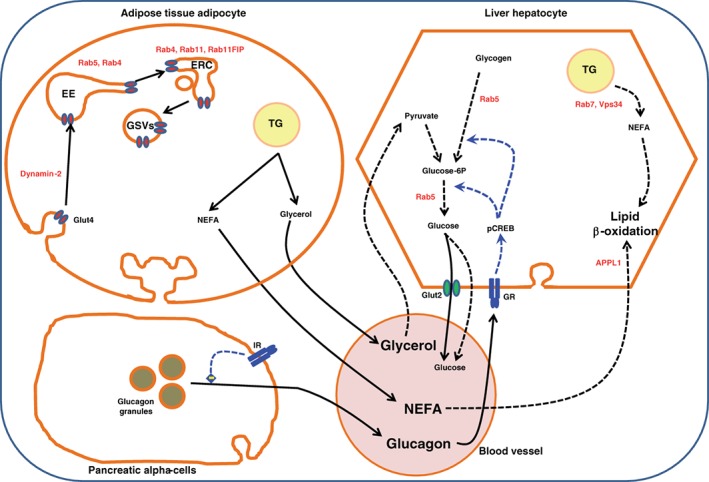Figure 2.

Involvement of endocytic components in systemic metabolism during the fasting period. During fasting, blood glucose levels drop, leading to a reduction in insulin secretion by pancreatic β‐cells. Instead glucagon is secreted from pancreatic α‐cells, which mainly acts on hepatocytes and induces a signaling cascade that shifts the genomic program towards catabolism, producing glucose either by the breakdown of glycogen or de novo synthesis from pyruvate through gluconeogenesis. Hepatocytes will also produce energy by breaking down their triglyceride stores into non‐esterified fatty acids and burning them via β‐oxidation. Concomitantly, in the adipocytes, the drop in insulin will stop GLUT4 translocation, which will be removed from the plasma membrane through endocytosis and stored in GLUT4 storage vesicles, leading to the arrest of glucose uptake by the adipocyte. This is also accompanied by an activation of triglyceride lipolysis releasing glycerol and NEFA into the blood. Glycerol will be used by hepatocytes to generate pyruvate essential for gluconeogenesis, and NEFA will be burned via β‐oxidation. Examples of endocytic components that play a role in these metabolic processes are labeled in red. EE, early endosomes; ERC, endosomal recycling compartment; GSVs, GLUT4 storage vesicles; ISGs, insulin secretory vesicles; LYS, lysosome; TG, triglycerides; GR, glucagon receptor; IR, insulin receptor; NEFA, non‐esterified fatty acids
